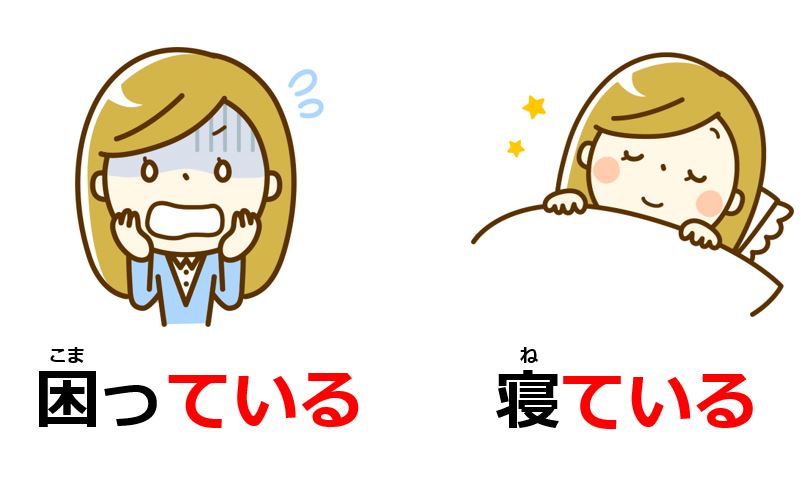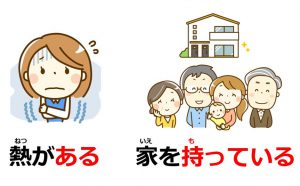Last time, you learned what the plain form can express, which are the two usages of present tense: constant states like “歯を磨くことは大切です (Brushing teeth is important),” and customary actions like “毎朝歯を磨きます (I brush my teeth every morning),” and future tense: “今から歯を磨きます (I will brush my teeth from now).” Then, if you want to say, “I’m brushing my teeth,” how would you say it? In this lesson, you will learn present progressive tense and resultant states.
How Present Progressive Tense and Resultant State Work with Te-form
| Table of Contents Present Progressive Tense Resultant State Motion Verbs with the Te-form + いる Customary Actions: the Plain Form VS. the Te-form + いる |
First of all, let’s learn what the te-form is. It is one of the most important forms to know when learning Japanese because it can be a base for other various forms, which include present progressive tense and resultant states. The conjugation rule is complicated when compared with others, especially when it comes to u-verbs. You have to conjugate u-verbs differently depending on the last character.
Conjugation Rule of the Te-form
Ru-verbs: Replace る with て
| Plain | Te-form | |
|---|---|---|
| To see, look (at), watch | 見る | 見て |
| To wear | 着る | 着て |
| To eat | 食べる | 食べて |
| To answer | 答える | 答えて |
Two Exceptions
| Plain | Te-form | |
|---|---|---|
| To do | する | して |
| To come | 来る | 来て |
U-verbs: Four Different Rules with One Exception
| Plain | Conjugation | Te-form | |
|---|---|---|---|
| To buy To wait To go back |
買う 待つ 帰る |
う => つ => って る => |
買って 待って 帰って |
| To die To hang out To read |
死ぬ 遊ぶ 読む |
ぬ => ぶ => んで む => |
死んで 遊んで 読んで |
| To write To swim |
書く 泳ぐ |
く => いて ぐ => いで |
書いて 泳いで |
| To talk | 話す | す => して | 話して |
| To go | *行く | Exception | 行って |
Further Conjugation
Again, the te-form can be a base for other forms. For example, if you attach いる, it indicates present progressive tense as shown below.
| Affirmative | Negative |
|---|---|
| 見て(いる / います) | 見て(いない / いません) |
| して(いる / います) | して(いない / いません) |
| 来て(いる / います) | 来て(いない / いません) |
| 買って(いる / います) | 買って(いない / いません) |
| 読んで(いる / います) | 読んで(いない / いません) |
Ongoing Actions (Present Progressive Tense) and Ongoing States (Resultant States)
Present progressive tense expresses what you are doing now, which you can think about as ongoing actions. By contrast, resultant states express a state resulting from a momentary action, e.g. “to get married” is a momentary action and will result in a state: “I’m married.” You can think about these states as ongoing states. Unlike English, we express them with only one form: te-form + いる.
Present Progressive Tense
| [私は・が] | 歌を | 歌って(いる / います) |
| [Topic / Subject] | Direct Object | Verb: Present Progressive |
| [I’m] singing songs. | ||
Present progressive tense is equivalent to “be + verb-ing” in English, and expresses continuous actions. This is very simple for English speakers. Here are more examples.
| 昼ごはんを食べて(いる / います)。 [I] am eating lunch. |
| サッカーをして(いる / います)。 [I] am playing soccer. |
| 笑って(いない / いません)。 [I] am not laughing. |
| 寝ている(の / んですか)? Are [you] sleeping? |
Resultant State
| [私は・が] | 着物を | 着て(いる / います) |
| [Topic / Subject] | Direct Object | Verb: Resultant State |
| [I] wear a kimono. | ||
The resultant states are expressed with various forms in English as shown by the translations below. However, you express this with only a single form: “te-form + いる” in Japanese. This may be a little confusing for English speakers. With the above example, 着る indicates just a momentary action like “to put on” and 着ている indicates a state which is equivalent to “to wear.”
| かばんを持って(いる / います)よ。 [I] have a bag. |
| 起きて(いる / います)。 [I’m] awake. |
| 怒って(いない / いません)。 [I’m] not angry. |
| 今、日本は晴れて(いる / いますか)? Is [it] sunny in Japan now? |
If you use the plain form of verbs which indicate states, you can express the moments that states will begin.
| かばんを(持つ / 持ちます)よ。 [I will] hold the bag. |
| 起きる / 起きます。 [I will] get up. |
| (怒る / 怒ります)よ。 [I will] get angry. |
| (晴れる / 晴れます)よ。 [It] will clear up. |
Note: verbs that indicate constant states cannot be “te-form + いる.”
水が要っている。 => Wrong!
水が要る。Lit. [I] need water.
Motion Verbs with the Te-form + いる
| 妹は | 学校に | 行って(いる / います) |
| Topic / Subject | Destination | Motion Verb |
| [My] younger sister went to school [and is there now]. | ||
If motion verbs with the te-form + いる are used with destinations, it can work differently and indicate that you have already finished moving and are still at the destination. Here are more examples.
| 台風が日本に来て(いる / います)。 A typhoon came to Japan [and is there now]. |
| 空港に着いて(いる / います)よ。 [I] arrived at the airport [and am there now]. |
You need to judge which function motion verbs work as based on the context when you use 行く and 来る. They work as normal progressive tense, too.
| 今海に行って(いる / います)。 [We] are going to the sea now. |
| バスがこっちに来て(いる / います)。 A bus is coming here. |
Supplementary Learning: Colloquial Expressions
昼ごはんを食べて(いる / います)。
サッカーをして(いる / います)。
笑って(いない / いません)。
寝ている(の / んですか)?
Native speakers often omit い from the te-form when they are casually speaking.
[adsense]
(Advanced Topic) Customary Actions: the Plain Form VS. the Te-form + いる
| 毎日8時間(寝る / 寝ます)。 |
| 毎日8時間寝て(いる / います)。 |
Customary actions can actually be expressed by both the plain form and the te-form + いる. The above examples have the same meaning: “[I] sleep for eight hours every day.” The difference of the nuance is still controversial among linguists.
| タバコはしばらく吸って(いない / いません) As for tobacco, [I] haven’t smoked for a while. |
| タバコはしばらく(吸わない / 吸いません)。 As for tobacco, [I] won’t smoke for a while. |
It is said that the te-form + いる implies that actions are temporary customs. With the above examples, only the first one indicates a customary action because しばらく indicates “not to smoke” is temporary.
| 魚は水の中で(生きている / 生きています)。 Fishes live in the water. |
| 魚は水の中で(生きる / 生きます)。 Fishes live in the water. |
However, the te-form + いる can often work even if actions are not temporary. Therefore, we can say that the te-form + いる is more versatile. If you have difficulty choosing the proper one, you may just use the te-form + いる.
Summary
- The te-form requires you to differently conjugate u-verbs depending on the last character.
- Present progressive tense indicates ongoing actions like “I’m learning Japanese.”
- Resultant states indicate ongoing states like “I wear Japanese clothes.”
- Motion verbs with the te-form + いる can indicates you have moved and stay there now.
For Japanese native speakers, it is very useful to be able to express present progressive tense and resultant states with a single form, because if something is ongoing, you can just use verbs with the te-form + いる. If you are confused, please try to memorize what each form can express. You have learned the plain form and the te-form + いる now. Next, you will dig into constant states in order to express existence and possession.





